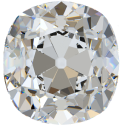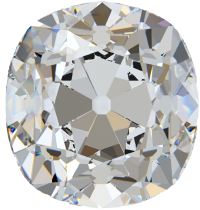
Old mine cut diamonds are diamonds that have been around for centuries, long before diamond cutters had the technology they have today. In fact, old mine cut diamonds were cut and polished by hand, making each cut entirely unique.
If you have an interest in antique diamonds, you’ve probably run across at least one old mine cut diamond. While they are beautiful, they also are an incredibly important part of the history of diamond cutting.
While there are many similarities between old mine cut diamonds to modern diamond cuts, there are also quite a few differences. Most of these differences can be attributed to the fact that old mine cut diamonds were cut and polished by hand, which makes it harder to do fine details like diamonds have today.


Small Table: Old mine cut diamonds have a small table, which is common with antique diamond cuts. You’re most likely to notice this when looking at an old mine cut diamond from above or looking at it side by side with a more modern cut, like a round cut.
Large Culet: In contrast, these diamonds have a large culet, which is where all of the facets join together into a point at the bottom of the diamond. The size of the culet is most noticeable when you look at it through the table.
High Crown and Deep Pavilion: When you look at an old mine cut diamond compared to modern ones, they have a much taller crown area, which is the top part of the diamond. The old mine cut also has a deep pavilion, which is the lower part of the diamond. These factors cause many old mine cut diamonds to be much taller than modern diamonds.
Short Lower Facets: Even though the diamond cut has a deep pavilion, you’ll notice shorter facets on the lower half of an old mine cut diamond. This feature makes the cut stand out compared to other antique cuts.
Imperfect Symmetry: One of the most telling features of an old mine cut diamond is that you will notice the facets aren’t symmetrical, and there are imperfections throughout the diamond. This is because all antique old mine cut diamonds were cut by hand, so there were likely to be mistakes or variations during the cutting process. However, this makes each old mine cut diamond have unique aspects compared to others of the same cut.

As mentioned earlier, old mine cut diamonds are an important part of the history of diamond cutting. This diamond cut can be traced all the way back to the 18th century when diamonds were measured and cut by hand. During this time, expert diamond cutters were known for their precision and eye for detail because of how they were able to transform diamonds by hand.
Old mine cut diamonds were incredibly popular from the early 18th century until the end of the 19th century. It was the most popular cut until the old European cut became more popular, as it was the stepping stone to the brilliant diamonds we know today.
The name “old mine cut” comes from the origin of diamonds when the cut was developed. During this time, diamonds were mined in India and Brazil. This caused the diamond to be named after where the stone came from – the oldest mines of the diamond industry.

Since old mine cut diamonds are antiques and were cut by hand, there are different factors you should consider when buying one compared to when you buy modern diamonds. Every old mine cut diamond is unique and needs to be looked at as such.
APPEARANCE: Focus on the appearance of the diamond instead of the four C’s (carat, color, clarity, cut). When old mine cut diamonds were created, there weren’t cut grades to go off of, so the way we judge diamonds now won’t work here. Instead, look at the unique characteristics that the stone has to offer, including shape and light reflection.
UNIQUENESS: It’s also important to not worry about the proportions of the facets or other specifics like that because they weren’t specifications that were focused on when old mine cut diamonds were being created. Every diamond cutter had their own way of designing these stones based on their background knowledge, which means each diamond is a little different.
SUITABLE: The color of an old mine cut diamond is also not something that you should focus on. Having color in the stone shouldn’t be considered a disadvantage. Instead, simply determine whether the color is beautiful to you or works with what jewelry piece you’re creating. Don’t expect to find a near-colorless old mine cut diamond. Instead, appreciate the color of the stone you find.
ANTIQUE: Remember that old mine cut diamonds are antiques which means they can be rare and hard to find. If you find one you like, it’s a good idea to close the deal because you have the chance to own an incredibly unique and beautiful piece of diamond history!


Old mine cut diamonds look much different than the lab grown diamonds that are becoming more and more popular. Since old mine cut diamonds were mined, cut, and shined by hand, they each have unique characteristics. In contrast, lab diamonds are cut using modern cutting technology, allowing for precise and uniform cuts every time.
However, purchasing an antique diamond or a lab diamond both are ethically sourced options for your diamond purchase. Buying a diamond that has been in existence for centuries doesn’t harm the earth through mining any extra while giving you a natural diamond. Purchasing a lab diamond also allows you to avoid harming the earth in order to receive the diamond you want!
Old mine cut diamonds are an important part of diamond history. They are an antique diamond cut that is eye-catching and unique, making them a beautiful addition to anyone’s diamond collection!

























